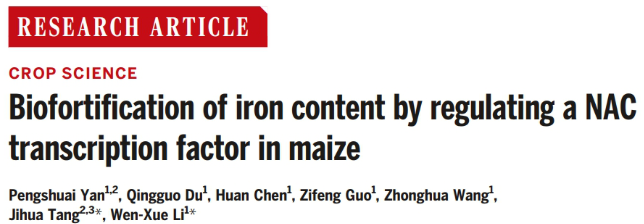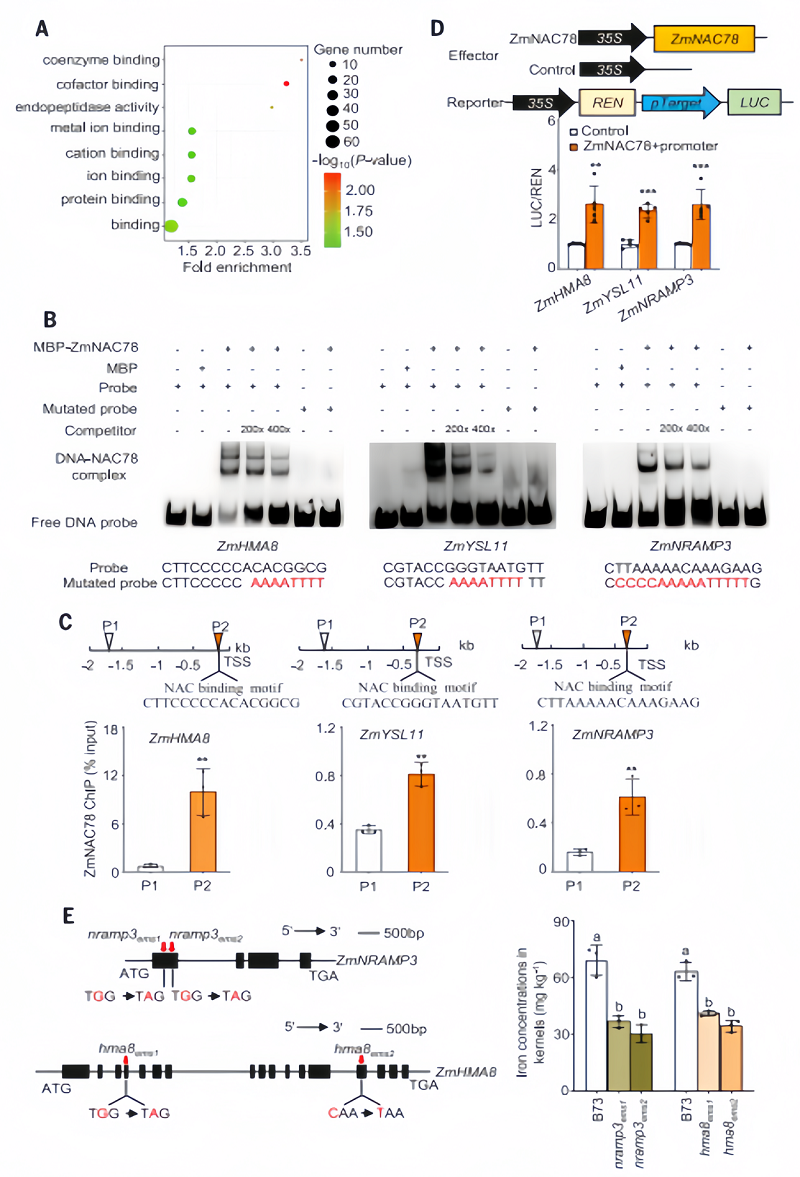Article information
Article title: Biofortification of iron content by regulating a NAC transcription factor in maize
Journal: Science
Date of Publication: December 8, 2023
Main content: Fortifying crops with micronutrients could be a good way to improve population health. Maize is a staple for many in sub-Saharan Africa, but the edible portions are typically low in iron. By investigating a population of natural genetic maize variants, Yan et al. identified a transcription factor that regulates iron content in the kernels. The authors found that some maize lines exhibited different sequences in the NAC78 promoter, and the presence of these promoter variants was correlated with the expression of NAC78 in the endosperm transfer cells. In these cells, iron transporters are up-regulated, suggesting that more iron is transferred into the kernel. This work opens a route to enhancing maize iron content, which may help to address iron deficiency where it is prevalent.
Article link: https://www.science.org/doi/10.1126/science.adf3256
Using TransGen product: TransZol Plant(ET121)

INTRODUCTION
Around a third of the world's population is dealing with anemia caused by a lack of iron. According to data from the Fourth National Nutrition Survey, 20.1% of Chinese residents have anemia, with half of those cases being due to iron deficiency. While taking iron supplements can help improve a person's iron levels, the cost is pretty steep. If we could boost the iron content in everyday crops, it would be a game-changer in fundamentally improving iron nutrition for a large number of people at a lower cost. This is especially crucial for developing countries that rely heavily on corn as a staple. However, generally speaking, there's a downside - the iron content in corn grains tends to be inversely related to the yield, putting a big damper on breeding corn varieties that are both high-yielding and iron-rich. In 2004, the Consultative Group on International Agricultural Research launched the "Biofortification Challenge Program," which has made significant strides in rice. However, due to differences in the structure of corn grains, the biological pathway for nutrients like iron to get in—via endosperm transferring nutrients to cells—is still a puzzling issue in the field of plant nutrition.
Article Overview
To start, this research used genotype data from 273 maize inbred lines along with transcriptome data from six extreme materials. The goal was to identify a candidate gene, ZmNAC78, responsible for regulating iron content in maize grains. ZmNAC78 shows high expression in maize endosperm 16-24 days after pollination, a critical phase for the rapid accumulation of nutrients in maize grains. Overexpressing ZmNAC78 in transgenic maize led to a grain iron content of 70.5 mg per kilogram, significantly surpassing the 60 mg per kilogram target set by the "Biofortification Challenge Program" for maize grain iron content.
Following that, the researchers delved deeper into uncovering the molecular pathway through which iron elements enter maize grains. Experiments demonstrated that ZmNAC78, predominantly expressed at the crucial interface where nutrients enter the progeny—the endosperm transfer cells of maize grains—can directly activate metal ion transport proteins ZmYSL11, ZmNRAMP3, and ZmHMA8. Experimental evidence revealed that all three iron ion transport proteins are highly expressed in the early stages of endosperm development, and these proteins are also expressed in the endosperm transfer cells, aligning with the expression time and spatial location of ZmNAC78. Further clarification came through experiments with gene function loss-of-function mutants, confirming that in the endosperm transfer cells, ZmNAC78 and metal transport proteins collectively form a molecular switch controlling the transport pathway for iron elements entering maize grains.
Lastly, in exploring the practical application of ZmNAC78 in breeding, researchers categorized maize into two types based on grain iron content: Type 1 with high iron content and Type 2 with low iron content. They used polymorphism in the core promoter sequence of ZmNAC78 to develop functional molecular markers. To mitigate the influence of environmental factors such as soil pH, three Type 1 hybrids were tested in the Huang-Huai-Hai region (Xinyang County, Henan Province, pH 8.5) and the Southwest maize region (Nanning City, Guangxi Province, pH 6.4). Results showed that their grain iron content consistently exceeded that of the Type 2 hybrids, averaging 25.82% to 33.91% higher. Furthermore, the selected hybrids significantly surpassed the average grain iron content of domestically bred hybrid maize varieties, which is 18.5 mg per kilogram. Notably, the grain iron content and yield of the Type 1 hybrids surpassed those of the domestic trial control variety Zhengdan 958, indicating that ZmNAC78 serves as a key gene for maize iron nutrition without negatively impacting yield. This offers a practical solution for breeding new maize varieties that are both high-yielding and iron-rich in the future.
CONCLUSION
In summary, this study not only uncovers the biological pathway of iron entering maize grains but also provides a fresh perspective on how nutrients make their way into cereal crops like wheat, which possess transfer cells. The research pioneers the development and application of molecular markers for breeding iron-rich maize varieties. By successfully selecting and breeding a new combination of maize with enhanced iron content, this study offers novel materials to address the issue of "hidden hunger" caused by the deficiency of trace elements like iron. Furthermore, it provides both theoretical and technical support for cultivating crop varieties that are not only high-yielding but also of high quality.

Activation of Iron Ion Transport Gene Expression by ZmNAC78
TransGen Product Support
High-quality reagents are a powerful tool for scientific research. TransZol Plant (ET121) contributed to this study.
TransZol Plant (ET121)
TransZol Plant is a ready-to-use reagent for the isolation of total RNA from polysaccharide-rich and/or polyphenol plant tissues, such as champignon, banana fruit, mango fruit, potato, carrot, sansevieria. It uses a modified CTAB method to lyse samples andphenol/chloroform to remove proteins and others impurities. It is also suitable for the isolation of total RNA from animal tissues like fat, connective tissues etc.
Features
• Superior lysis capability and higher RNA yield.
• The whole procedure can be completed in one hour.
• Pink solution for easy visualizing different phases.
• Unique dissolving solution for long-term RNA storage.
Some articles published using the TransZol Plant (ET121):
• Yan P S, Du Q G, Chen H, et al. Biofortification of iron content by regulating a NAC transcription factor in maize [J]. Science, 2023.
• Wang L, Tian T, Liang J, et al. A transcription factor of the NAC family regulates nitrate‐induced legume nodule senescence[J]. New Phytologist, 2023.
• Zhang Y, Gao Y, Wang H L, et al. Verticillium dahliae secretory effector PevD1 induces leaf senescence by promoting ORE1-mediated ethylene biosynthesis[J]. Molecular plant, 2021.
• Zheng X, He L, Liu Y, et al. A study of male fertility control in Medicago truncatula uncovers an evolutionarily conserved recruitment of two tapetal bHLH subfamilies in plant sexual reproduction[J]. New Phytologist, 2020.
TransGen products have once again been featured in the Science journal, which proves customer's recognition of the quality and strength of the TransGen products. This achievement also aptly reflects TransGen's longstanding commitment to the principle of 'Quality is the highest priority, serving customers with superior quality and service.' TransGen remains dedicated to supporting scientific research and looks forward to collaborating with more researchers in the future. TransGen’s aim is to contribute to scientific endeavors with an expanding array of superior products, furthering our commitment to advancing research through excellence.








